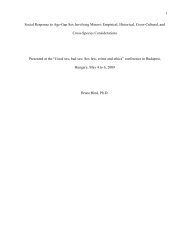Infant and Child Sexuality: A Sociological Perspective - Ipce
Infant and Child Sexuality: A Sociological Perspective - Ipce
Infant and Child Sexuality: A Sociological Perspective - Ipce
Create successful ePaper yourself
Turn your PDF publications into a flip-book with our unique Google optimized e-Paper software.
<strong>and</strong> as quickly as possible.<br />
Mothers who chose to start toilet training before the infant was<br />
five months old had the lowest average rating on a sexual permissiveness<br />
scale. That is, they expressed strong rejection of sex <strong>and</strong> strict<br />
attitudes about prohibiting sexual play in their children. This tendency<br />
was more pronounced among the mothers of girl infants than among<br />
boy infants.<br />
Early starts on training tended to require longer periods for completion<br />
than late starts, yet the mothers who started early <strong>and</strong> had<br />
high sexual anxiety completed the task more rapidly than did those with<br />
low sexual anxiety who started later. The difference was statistically<br />
significant. (Sears, et al, 1957, p. 112). The evidence seems clear<br />
that the mother’s level of sexual anxiety--her strictness of attitude<br />
about sex--played some role in her decision to start toilet training at<br />
an early age <strong>and</strong> to complete it with dispatch. Mothers who had an accepting,<br />
tolerant attitude toward the infant’s dependent behavior were<br />
also: affectionally warmer toward the child, gentler about toilet<br />
training, lower in their use of physical punishment for aggression toward<br />
parents, <strong>and</strong> higher in esteem for both self <strong>and</strong> husb<strong>and</strong>. (Sears,<br />
et al, 1957, p. 166). It is reasonable to assume that the sexually anxious<br />
mother communicates some of her sexual anxiety to her infant in<br />
toilet training encounters.<br />
Has there been any change in permissiveness of mothers <strong>and</strong> has<br />
there been any increase or decrease in infant-mother intimacy over the<br />
years? The evidence is indirect <strong>and</strong> superficial at best. Several students<br />
of child behavior have examined the child-guidance literature <strong>and</strong><br />
report a change in attitudes. (Stendler, 1950; Sears, et al, 1957, p.<br />
9-10; Gordon, 1968). The 1890s <strong>and</strong> 1900s were characterized by a highly<br />
sentimental approach to child rearing as demonstrated in popular periodicals;<br />
1910 through the 1930s saw a rigid, disciplinary approach;<br />
while the 1940s emphasized self-regulation <strong>and</strong> underst<strong>and</strong>ing of the<br />
child. Over the 60 years there was a swing from emphasis on character<br />
development to emphasis on personality development. In the 1914 edition<br />
of <strong>Infant</strong> Care, masturbation by infants was treated very severely.<br />
It was thought that masturbation would “wreck” a person for<br />
life, <strong>and</strong> it was to be stopped by tying the infant’s legs to opposite<br />
sides of the crib. In subsequent editions there was a fairly continuous<br />
decline in the degree of severity recommended. The 1951 edition of<br />
<strong>Infant</strong> Care treated masturbation as a rather petty nuisance that might<br />
be ignored. Along with permissiveness went a distinct devaluing of the<br />
satisfactions a child gets from such stimulation. In respect to thumbsucking,<br />
the curve of severity showed a distinctly declining direction<br />
as well. In fact, during the 1940s instructions regarding the h<strong>and</strong>ling<br />
of the infant in all areas became very gentle. This tendency continued<br />
<strong>and</strong> was carried further in the 1951 <strong>and</strong> 1963 editions. The 1963 edition<br />
counsels that masturbation is to be treated casually. Habitual<br />
masturbation is never mentioned nor is any attempt made to dispel the<br />
1 Rejection of the suckling infant may be selective by sex, also. In a<br />
Swedish study (Dahlström, p. 65) involving 18 families, girl babies<br />
were suckled on an average of only three months after birth; boy babies<br />
were suckled for an average of six months.<br />
17
















